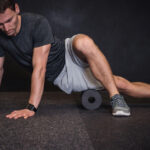In the sacred world of yoga, every drop of sweat tells a story. Whether it’s the muscles stretching, energies aligning, or the mind-body connection strengthening with each pose, the link between perspiration and transformative yoga experiences is profound.
Perspiration is more than just our body’s cooling mechanism. It’s a tangible manifestation of our inner fire or ‘agni’. As we engage in each asana, our body heats up, facilitating not only physical flexibility but also helps in detoxification and purification.
But here’s where it gets even more intriguing. Just as a potter requires tools to mould clay into art, a yogi can benefit immensely from perspiration-boosting accessories. These aren’t just add-ons; they play a pivotal role in refining and optimising one’s practice.
Understanding Perspiration in Yoga
The union of mind, body, and soul that defines yoga takes on an added dimension when we consider the role of perspiration. But what really happens when we sweat during our yoga practice? And how does it truly influence our yogic journey?
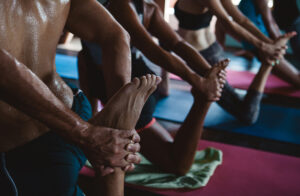
The Science Behind Sweating
At its core, perspiration is our body’s natural cooling mechanism. When our internal temperature rises, our sweat glands produce a watery fluid – sweat – which, when evaporated, cools down the body. This mechanism is incredibly active during physical activity, and yoga is no exception.
Moreover, sweat isn’t just water. It contains trace amounts of minerals, such as sodium, potassium, calcium, and magnesium. The act of sweating can also be seen as a detoxification process, as it helps in releasing certain toxins from our system.
How Perspiration Enhances Yoga
Detoxification: As we sweat, we expel toxins. In the context of yoga, this physical detoxification can mirror the mental and spiritual cleansing that yoga advocates. As the body rids itself of unwanted elements, the mind, too, feels clearer and more focused.
Increased Flexibility: Heat generated during yoga softens the muscles, making them more pliable. This malleability can lead to deeper stretches and enhanced flexibility, making it easier to achieve and hold challenging poses.
Mind-Body Connection: The very act of sweating can be a mindful reminder of the effort being invested. It’s a tangible manifestation of the commitment to the practice, further anchoring the yogi’s presence on the mat.
Common Misconceptions about Sweating in Yoga
More Sweat Equals a Better Workout:
While it’s true that intense physical activity can lead to more sweating, the amount of sweat isn’t always a direct indicator of the quality or effectiveness of a yoga session. Different bodies react differently to heat and exertion.
Sweating Excessively Means Burning More Calories:
The act of sweating itself doesn’t burn calories. It’s the underlying activity that might. Hence, a sweaty yoga session doesn’t necessarily mean a higher caloric burn than a less sweaty one.
Sweating a Lot Means You’re Out of Shape:
Some people naturally sweat more than others, irrespective of their fitness levels. It’s essential not to judge oneself or others based on the amount of perspiration produced.
Benefits of Perspiration in Yoga
There are many important benefits of perspiration, which in turn plays a critical role in yoga practice to make the most out of the workouts.
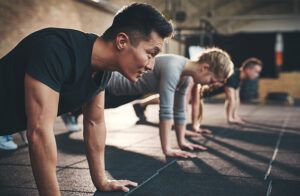
Natural Detoxification Process
The human body is akin to a meticulously designed machine, with each component serving a distinct purpose. Among its various functions, the skin, through perspiration, acts as a natural excretory pathway, aiding in detoxification.
- Expelling Toxins
One of the primary benefits of sweating is the removal of toxins from the body. As we sweat, we release a mix of water, salt, and other waste products. This includes toxins like heavy metals (e.g., lead, mercury, and cadmium) and certain harmful chemicals, aiding in their elimination from the body. Regular yoga practice, which promotes perspiration, can hence act as a natural detox mechanism.
- Kills Bacteria
Sweating helps fight off pathogens to support better working of the immune cells. Our sweat has a tiny substance called dermcidin, which fights bacteria and germs that can make you sick.
Perspiration and Its Role in Flexibility and Injury Prevention
Yoga’s essence lies in achieving a perfect blend of strength and flexibility. Perspiration, often an overlooked element, plays a significant role in this delicate balance.
- Warming Up Muscles
As we practise yoga, the heat generated causes muscles to become more elastic. Sweating is an indicator of this warmth. When muscles are warm, they can stretch further without the risk of strain.
- Deepening Stretches
Warm muscles, lubricated joints, and an increased range of motion due to perspiration allow yogis to delve deeper into poses. This deepening not only enhances the benefits of each asana but also fosters greater flexibility over time.
- Preventing Injuries
Dry, cold muscles are more susceptible to injuries as they can easily tear or strain. A body that’s warmed up and sweating has increased blood flow to the muscles, ensuring they are oxygenated and nourished. This significantly reduces the chances of injuries during a yoga session.
Yoga Accessories for Perspiration Enhancement
By now, we have figured out the significance of the role that perspiration plays in our lives. Why not take our yoga sessions up a notch and make more out of them by enhancing perspiration?
So, let’s explore the benefits of yoga accessories for sweating, which are thoughtfully designed to complement your sweaty sessions. And, delve into the functions and benefits of these tools.
A. High-Quality Yoga Mats
At the most basic level, a yoga mat is a specially designed padding that provides a cushioned and non-slip surface for practising yoga. Since they are non-slippery, they prevent slipping during sweat-intensive sessions, offering a stable foundation for poses.
Yoga mats specifically designed to handle perspiration go beyond the basic functionalities of regular mats. When engaging in sweat-inducing yoga practices like hot yoga, Bikram, or intense vinyasa flows, these mats come to the forefront as invaluable allies. Here are the tailored benefits they offer:
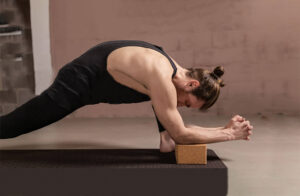
- Superior Grip in Wet Conditions: Unlike standard mats that can become slippery when wet, perspiration-boosting mats are designed to offer even better grip as they get wetter. This ensures stability in poses, especially during intense sweat sessions.
- Hygienic Surface: With frequent sweating, the potential for bacterial and fungal growth increases. Perspiration-boosting mats are typically treated or constructed with antimicrobial properties, keeping them sanitary even after sweaty sessions.
- Sweat Absorption: Some high-end perspiration-boosting mats come with layers that absorb sweat, ensuring that the surface remains relatively dry, providing consistent grip throughout the session.
Related Article: 40 Yoga Exercises for Beginners on Yoga Mat
Choosing the Right Yoga Mat
When choosing a yoga mat for sweating, here’s what you should look for to make the right choice:
Material Matters:
- PVC (Polyvinyl Chloride): A common material that offers excellent grip and durability but is not biodegradable.
- TPE (Thermoplastic Elastomer): A more eco-friendly alternative to PVC. It’s lightweight and offers good cushioning.
- Natural Rubber: Offers a good grip and is biodegradable, but might not be suitable for those allergic to latex.
- Cotton and Jute: These are natural, biodegradable materials, but they tend to have a rougher texture.
Thickness and Cushioning:
- Thin (1/16 inch): Good for travelling. Provides more direct floor contact and less cushion.
- Standard (1/8 inch): Offers a balance between comfort and portability.
- Thick (1/4 inch or more): Provides excellent cushioning, ideal for those with joint issues, but is bulkier to transport.
Non-Slip Features:
- Look for mats labelled “non-slip” or “anti-skid”. This is essential for maintaining stability in poses, especially when sweating.
- Some mats have textured surfaces to provide extra grip.
Eco-Friendly Options:
- Natural Rubber Mats: Derived from rubber trees, these mats are biodegradable but can be a bit heavier.
- Cotton and Jute Mats: Fully biodegradable and provide a natural feel.
- TPE Mats: Though synthetic, they are more environmentally friendly than PVC mats as they can be recycled.
- Eco-Friendly Coatings: Some mats come with special coatings that are free from harmful chemicals and dyes.
B. Sweat-Enhancing Yoga Apparel
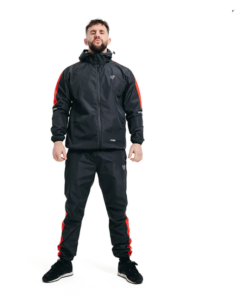
Yoga is not just internal alignment but also requires external support. In intense sessions where perspiration is a natural outcome, what you wear can dramatically affect your practice. Herein lies the importance of sweat-wicking yoga apparel, with sauna suit emerging as a leading choice for many practitioners.
Role of Sweat Enhancing Apparel in Yoga
Yoga sessions can vary in intensity and purpose. For those practices targeting detoxification and weight loss, maximising sweat becomes essential. Sweat vest are specially designed apparel to trap body heat, and as the name suggests, they promote intense sweating when worn during physical activities.
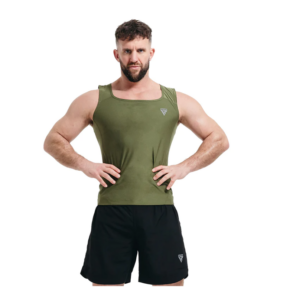
Be it men or women workout vests serve the amazing purpose of boosting the amount of sweat produced by increasing the body’s core temperature. This intensified sweating is believed to help with detoxification as the body expels more toxins through perspiration. They also work amazingly in expediting water weight loss.
Related Article: This 20-Minute At-Home Routine Will Make You Sweat
What to Look For in Yoga-Centric Apparel
Fabric Selection:
Insulating Materials: Materials that trap heat, like neoprene or vinyl, are often used in sauna sweat suit. They amplify body temperature, leading to increased sweat production.
Non-breathable Layers: These fabrics prevent the rapid evaporation of sweat, ensuring the body continues to sweat profusely throughout the session. Due to such fabric choices, sauna suits aid in weight loss.
Fit and Comfort:
Close-Fitting but Flexible: Sweat-enhancing apparel should contour closely to the body to trap heat effectively. However, it should still offer enough flexibility for a range of yoga poses.
Soft Inner Linings: Given the increased sweat, soft inner linings can offer additional comfort and reduce potential skin irritations.
Breathability:
Limited Breathability by Design: Unlike regular workout clothes, workout sweat vest limits breathability on purpose. This ensures that heat is retained, making the body work harder and sweat more.
Safety Note: It’s essential to stay hydrated and monitor your body’s responses, as excessive sweating can lead to dehydration.
Related Article: 5 Safety Rules For Weighted Vests Training
C. Yoga Towels
Yoga towels are specially designed towels that either fit on top of a yoga mat or can be used in place of one to prevent slipping due to moisture. Typically made of microfiber, they have a soft, absorbent surface on one side and a grippy texture on the other. Unlike regular bath towels, yoga towels are engineered to handle the unique demands of a yoga practice, especially sessions where sweat is abundant.
Benefits of Using a Yoga Towel
Enhanced Grip
As you sweat, traditional yoga mats can become slippery. A yoga towel absorbs this moisture, preventing slips and providing a stable foundation for poses, even in the most intense sessions.
Hygiene
Layering a yoga towel on a mat ensures that the sweat is absorbed by the towel, keeping the mat cleaner. This is especially useful if you’re using shared mats in a studio setting. Plus, yoga towels are easy to wash, ensuring you always have a fresh, clean surface for every practice.
Versatility
In scenarios where you might not have a mat, like a beach or a park, a yoga towel can serve as a makeshift mat, offering a barrier between you and the ground.
D. Grippy Yoga Gloves and Socks
Yoga is a practice that not only requires focus but also entails a lot of sweating. This often leaves yogis feeling slippery and sliding around on their mats. This is where perspiration-boosting yoga socks and yoga gloves come in handy.
These accessories are designed to boost perspiration and enhance grip, allowing you to stay focused on your practice, maintain your form, and get the most out of your yoga session. But when should you wear them?
The answer depends on your unique needs and preferences. Some yogis wear them during challenging sessions or when they sweat excessively, while others use them as a regular part of their yoga gear.
How Yoga Gloves Improve Stability
- Enhanced Traction: The grips on the gloves provide added friction, ensuring the hands don’t slide, especially during weight-bearing poses like Downward Dog or Plank.
- Compensates for Sweaty Palms: For individuals whose palms sweat excessively, these gloves act as a barrier, preventing moisture from compromising their grip.
- Versatility: For those practising without a mat, like on a carpet or grass, grippy gloves offer the essential traction needed.
Benefits of Using Yoga Socks:
Yoga socks are another excellent yoga gear for enhanced perspiration. They are designed to help keep your feet dry and prevent slipping during your yoga practice. These socks feature special materials that help wick away moisture and provide extra grip on your mat.
By keeping your feet dry and reducing the risk of slipping, perspiration-boosting yoga socks can help you maintain proper form and reduce the risk of injury. Additionally, these socks can help you feel more confident and comfortable during your yoga practice, ultimately enhancing your overall experience.
How to Incorporate Accessories into Your Yoga Routine
Incorporating yoga accessories like grippy gloves, socks, towels, and more can elevate your practice by providing added safety, comfort, and functionality. Here’s how to seamlessly integrate these tools into your routine:
1. Evaluate Your Needs
Start by assessing what your yoga practice often demands. Do you sweat a lot? Do you find your feet slipping during poses? Understanding your specific needs will help you choose the right accessories.
2. Begin with Basics
If you’re new to using accessories, it’s better to start small. Introduce one accessory at a time to avoid feeling overwhelmed. Before diving into a full session, spend some time getting accustomed to the feel of the accessory. For instance, walk around in your yoga socks or practise basic poses with gloves on.
3. Incorporate Yoga Towels
When using a yoga towel for sweat, spread it evenly over your mat. This will absorb sweat and prevent slipping. If it’s an intense session and you sweat profusely, keep an extra towel nearby. Swap it out if the first becomes too damp.
4. Utilise Grippy Gloves and Socks
Begin your session with them on, especially as hot yoga accessories, where you’ll start sweating quickly. These accessories shine in poses where stability is essential. Focus on grounding your hands in poses like Downward Dog or your feet in poses like Warrior series.
Conclusion
Perspiration plays a critical role in our body’s mechanism, but it becomes even more critical during yoga practices when sweating intensely can lead to detox, temperature regulation and enhancement in workout performance.
With the integration of sweat-inducing yoga props like towels, gloves, mats, and apparel, you can amplify your yoga experience. It doesn’t only help enhance our physical practice but also deepens our mind-body connection. So, the next time you step onto a mat, remember that every drop of sweat counts!




